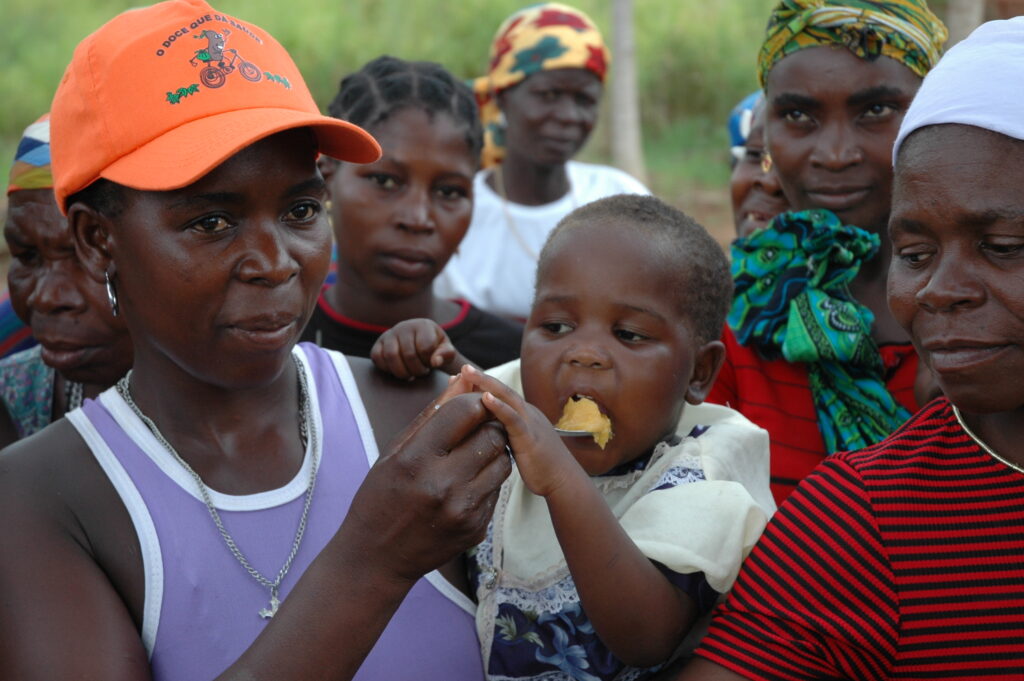Thanks to vitamin A orange sweet potatoes, children in Mozambique are less at risk of suffering from vitamin A deficiency, finds a study published in the British Journal of Nutrition this month. More than two-thirds of children under five in Mozambique are vitamin A deficient, impairing their growth and increasing their risk of infection.
Interventions that combine agriculture and nutrition are thought to have the potential to improve nutrition outcomes in low- and middle-income countries. Only a select few have successfully demonstrated rigorously that this is the case.
One such intervention is HarvestPlus’ Reaching End Users (REU) project. From 2006 to 2009, the project introduced vitamin A orange sweet potatoes (OSP) to farmers in Mozambique and Uganda with the aim of reducing vitamin A deficiency among children under the age of five and women of reproductive age. The orange sweet potatoes’ micronutrient content was enriched through conventional plant breeding methods in a process known as biofortification so that regular consumption of OSP generates measurable improvement in nutrition and health. Most varieties of sweet potatoes in Africa south of Sahara are white due to a lack of beta-carotene, a vitamin A precursor.
The project distributed vitamin A OSP vines and trained households how to plant, disinfect, and preserve them. Mothers were offered training on consumption, preparation methods, and health. A marketing component increased visibility and demand for vitamin A orange sweet potatoes in local markets. A randomized-controlled impact evaluation conducted on this project found that among targeted children and their mothers, vitamin A intake increased while vitamin A deficiency prevalence decreased as a result of the intervention.
In 2012—three years after the project ended—researchers returned to conduct socioeconomic and dietary intake surveys with a sample of the beneficiary households to understand the sustainability of the impact of the project on vitamin A intake and prevalence of vitamin A deficiency. Thanks to those able to retain vines or obtain vitamin A orange sweet potato planting material from their neighbors, vitamin A intakes remained higher among beneficiary villages. Significantly, researchers found lasting impacts on vitamin A intakes among children aged 6–35 months (not yet born when the initial intervention ended) and their mothers.
“The study demonstrates that lasting impacts from biofortification interventions are possible,” said Alan de Brauw, the lead author. “We need to rethink what that means for the cost-effectiveness of such interventions, as we show that some of the REU beneficiaries were born after the program ended.” Since the next generation of children also benefit, costs per beneficiary decrease.
The work follows findings published in 2015 demonstrating that the REU project reduced the prevalence and duration of diarrhea in children under five who consumed vitamin A sweet potatoes. Findings published in 2018 suggested the importance of sharing planting materials, as increases in vitamin A intake were largely explained by increases in adoption.
“The findings reinforce that biofortification is highly cost-effective over time—and suggest the sustainability of its impact over generations and planting seasons,” says Ekin Birol, HarvestPlus’ Director of Impact and Strategy. “HarvestPlus aims to catalyze the scale-up of biofortified crops so that more children and mothers benefit.”
Biofortification helps address preventable deficiencies of key vitamins and minerals like iron, vitamin A and zinc. Globally, interventions like biofortification that reduce micronutrient deficiencies are also considered the highest value-for-money investments for economic development. Since 2004, HarvestPlus and the International Potato Center have facilitated the release of more than 340 varieties of 11 biofortified crops in more than 40 countries.
